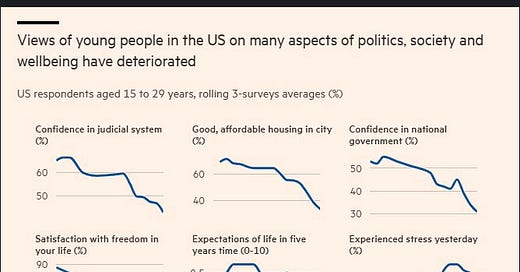This weekend, the Wall Street Journal ran an essay titled “There’s a Good Chance Your Kid Uses AI to Cheat.”
Okay, so there is a good chance all of our children and students are “cheaters.” I’m working on another post explaining why that is a horrible frame and nothing more than an excuse for many adults who have done almost nothing to help students prepare for the transition to a new industrial era. But today, I just want to make the case that we’ve dealt our students a very tough hand. This is a hand that few of us, maybe none, could successfully play.
These are 10 cards we’ve dealt them.
AI and the future of uncertain work. The integration of AI into various industries has brought profound changes to the nature of work. AIs can already do a lot of associate-level legal and consulting work that would normally pay our most ambitious students well. Within 10 years AI may be able to all the “knowledge work” we are training our students to do (Hassabis) and do it without human assistance (Schmidt).
Today’s students understand that much of what they learn may not assist them in gaining employment.
Mass, unexpected layoffs are making this worse.
Students today face an uncertain future where they must compete not only with peers but also with machines. The gig economy means students are entering a job market increasingly defined by temporary work, limited benefits, and reduced job security.
The gutting of the public support/social infrastructure in the US. Cuts to social programs have left students and families without essential safety nets. From healthcare to housing assistance, reductions in federal spending disproportionately harm vulnerable populations, including young people starting their adult lives.
These policies undermine the stability necessary for educational success and economic mobility, leaving students to navigate a system that increasingly prioritizes austerity over investment in human potential.
Every individual who has thought about AI and the world thinks that during the transition to an AI world (we are in it now), social supports need to be increased. In the US, we are cutting those supports.
AI and emerging violent conflict. The transition to an AI world is very likely to be violent, as AI will introduce massive changes in the economy, governance, and social relations (including the existing social contract). The militarization of AI magnifies this.
Every leading voice on AI believes the transition to the emerging AI world will produce incredible violence, even if the long-term upside is positive (Schmidt; Mundie; Geortzel; LeCun).
And, of course, there are growing risks of conflict between the US and Iran as well as a potential reordering of the world between spheres (Asia/China, Americas/US, Europe/Russia, Middle East (Saudi Arabia, Israel). We currently cannot even rule out wars with Canada and Mexico.
Federal education and related cuts and a declining economy trigger declining support for public education. The erosion of public education funding will create significant barriers for students seeking quality learning experiences.
Federal cuts and privatization initiatives funnel resources away from public schools, leaving them underfunded and understaffed. This decline disproportionately affects low-income communities, exacerbating educational inequities and limiting opportunities for upward mobility.
Of course, such changes, including a growing role for AI and the private sector, may improve education over the long term, but they will also be incredibly disruptive in the short term, with many students experiencing a loss of educational opportunities over the next few years.
Social targeting of minority groups, such as LGBTQ. Marginalized groups, including LGBTQ+ individuals, face heightened discrimination in both social and institutional settings. Racial oaggressions, homophobia, and transphobia create hostile environments that hinder academic performance and mental health. Students in these communities often struggle to access safe spaces or equitable opportunities, further compounding their challenges. In the current political environment, they feel even more pressure.
Most of the ideals they’ve learned about in history class—democracy, human rights, protecting refugees after World War II, including everyone, diversity—are all under attack. For example, the US recently withdrew from the Human Rights Treaty, reduced the refugee cap to zero, and rescinded rules that aim to reduce civilian casualties in warfare.
Student debt burden. Students are starting adult life with significant educational debt that previous generations didn't face at the same scale. The soaring cost of higher education has saddled students with unprecedented levels of debt. Unlike previous generations, today’s graduates begin their careers facing financial constraints that limit their ability to invest in homes, businesses, or families. This debt crisis perpetuates inequality and discourages risk-taking among young professionals.
This is, of course, magnified by employment insecurity.
Polarized information landscape. Students must navigate an era defined by misinformation and algorithm-driven content that amplifies political divisions. Determining truth has become increasingly difficult as social media platforms prioritize engagement over accuracy, and synthetic media becomes indistinguishable from reality. This polarized landscape undermines critical thinking skills and creates challenges for civic engagement.
Climate anxiety and environmental uncertainty. Students are coming of age during increasing climate disasters, biodiversity loss, and uncertainty about the planet's future. Many feel they're inheriting environmental problems created by previous generations that they'll be responsible for solving.
Mental health epidemic. Record levels of anxiety, depression, and loneliness among young people reflect a broader mental health crisis exacerbated by societal pressures and pandemic isolation.
A desire to blame it all on them. Rather than addressing systemic issues, society often shifts blame onto students themselves—criticizing them for using AI tools, failing to put their phones in pouches, vaping, or going to the bathroom too often.
But given the hand we’ve dealt them, is this any surprise?
This scapegoating ignores the broader context in which these behaviors arise and absolves adults from responsibility for creating supportive environments that foster growth. By dealing students this tough hand, we have placed them at a disadvantage and then blamed them for their reaction.
Maybe our students could do better, but so could we, and calling them “cheaters” won’t help them.




